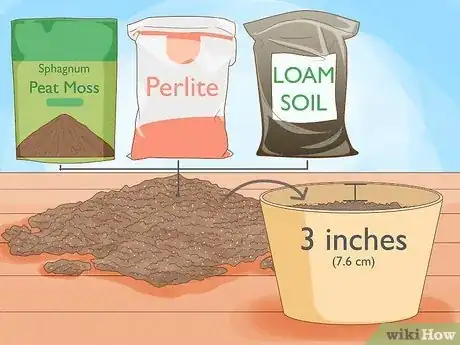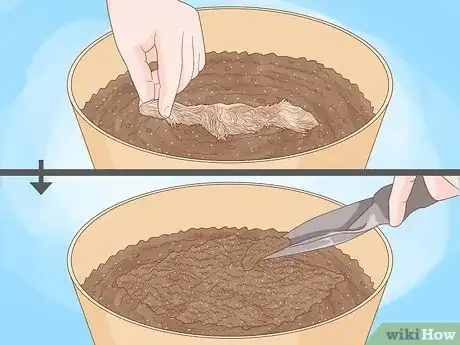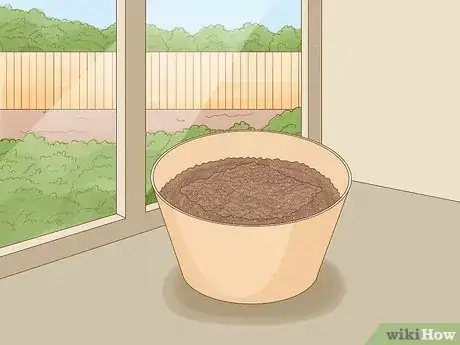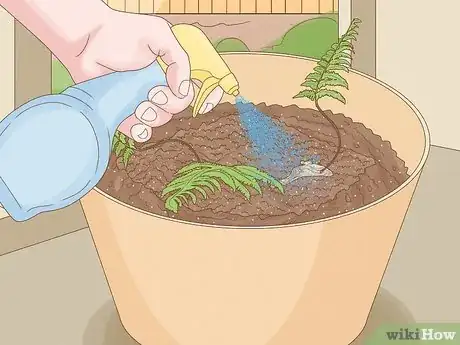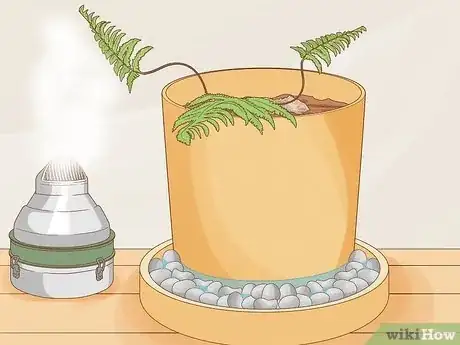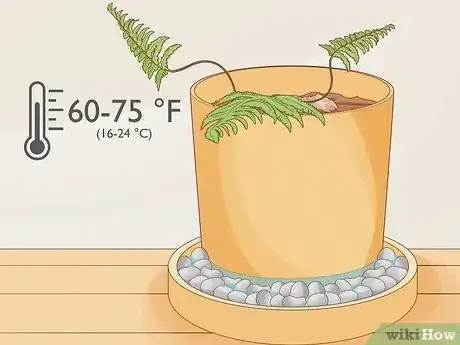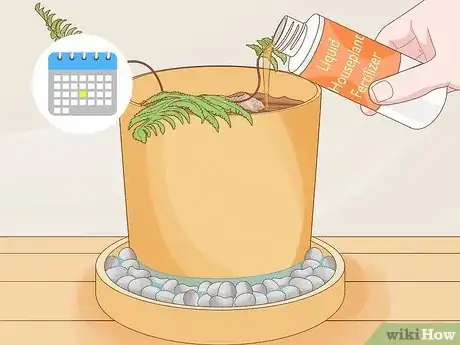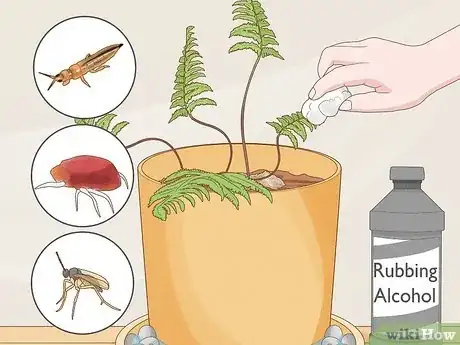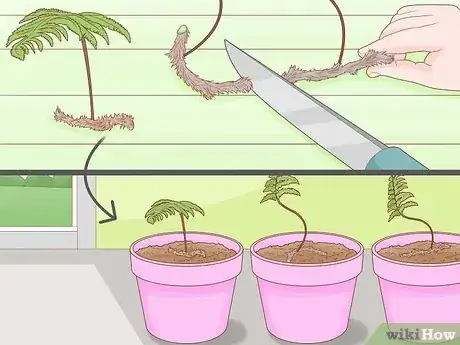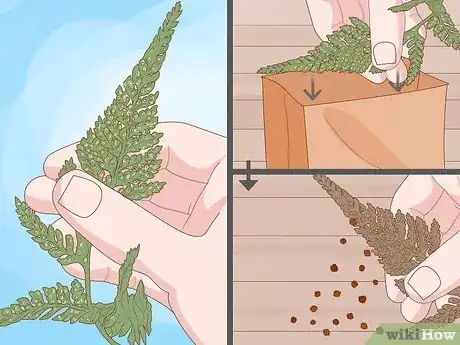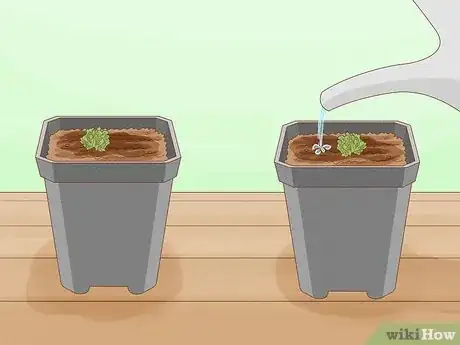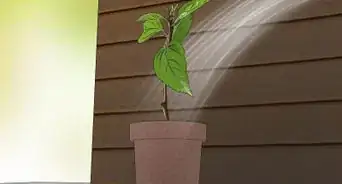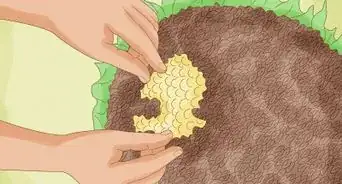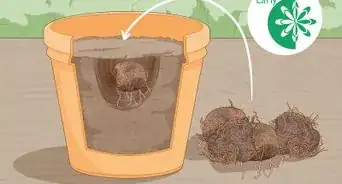This article was co-authored by Lauren Kurtz. Lauren Kurtz is a Naturalist and Horticultural Specialist. Lauren has worked for Aurora, Colorado managing the Water-Wise Garden at Aurora Municipal Center for the Water Conservation Department. She earned a BA in Environmental and Sustainability Studies from Western Michigan University in 2014.
wikiHow marks an article as reader-approved once it receives enough positive feedback. This article received 19 testimonials and 100% of readers who voted found it helpful, earning it our reader-approved status.
This article has been viewed 233,518 times.
The rabbit foot fern (Davallia fejeensis) is a native of Fiji. It can be grown outdoors in warm climates (USDA hardiness zones 10 to 11), but is most commonly grown as a houseplant.[1] The decorative fern's distinctive light brown fuzzy rhizomes resemble rabbit feet, giving the fern its name. By knowing how to plant, water, and care for your rabbit foot fern, you can have a happy and healthy houseplant.
Steps
Planting Your Rabbit Foot Fern
-
1Purchase a rabbit foot fern plant. Because rabbit foot ferns do not grow from seeds, but instead are propagated by dividing rhizomes or collecting spores, you must buy an existing plant. Your fern can still be a young plant when you buy it.[2] Rabbit foot ferns are available at garden centers and through online distributors.
- Choose a plant that looks vibrant, green, and healthy. If you notice any brown or wilting leaves, pick out a different plant.
-
2Plant the rabbit foot fern in a hanging basket. Since the rhizomes hang over the sides of the container and can grow up to 2 feet (0.61 m) long, the rabbit foot fern is ideal for a hanging basket.[3] The container should be either plastic or clay, and 6–10 inches (15–25 cm) in diameter.
- Plastic containers tend to allow for a more even distribution of water than clay pots, but clay pots are sturdier and may last longer.
Advertisement -
3Grow the fern in porous soil that drains well. You can find a porous soil mix at your local gardening store. A great soil mix should contain 2 parts peat moss, 1 part loam, and 1 part sand or perlite, which is a volcanic glass with a high water content. The soil should have a neutral pH of 6.6 to 7.5.[4]
- Fill your container about 3 inches (7.6 cm) from the top with soil mix.
- Soil that doesn’t drain well will hold too much moisture and cause the plant to rot.[5]
-
4Plant rhizomes near the top of the soil. Rabbit foot ferns have shallow root systems. When you plant your fern in its container, make sure to not plant it too deeply. Keep the rhizomes at the surface of the soil so they don’t rot.[6]
-
5Place the rabbit foot fern in indirect light. During the winter months in the northern hemisphere, a north-facing window is an ideal location for the fern. During the spring and summer months, when the sun is higher on the horizon, choose an east-facing window with filtered light.
- Avoid south- and west-facing windows where the direct sunlight may burn the fern's leaves.
Caring for Your Plant
-
1Water the fern sparingly. Allow the soil in the container to dry out slightly between waterings. When the soil is dry or almost dry to the touch, it's time to water. Over-watering will cause the leaves to yellow and may result in root rot.[7] Do not allow the plant to sit in water.
- Mist the fuzzy rhizomes regularly. Give them water every few days, or as needed, to prevent them from drying out.[8]
-
2Grow the fern in a moderately humid environment. If your heat is on in your home during winter months, consider using a room humidifier where your rabbit foot fern is located.
- If you don't have a room humidifier, place the fern's container on a tray of wet pebbles to increase the humidity around the plant. Refill the tray as the water evaporates.
-
3Maintain a 60–75 °F (16–24 °C) environment. The rabbit foot fern will thrive indoors in comfortable house temperatures. If the temperature drops below 60 °F (16 °C), check the plant before watering and only water when the soil is dry to the touch.
- If the temperature rises above 75 °F (24 °C), you may need to water the plant more often.
-
4Fertilize the rabbit foot fern monthly. Any liquid houseplant fertilizer can be used to feed the fern, but use only about half the recommended amount. Too much fertilizer may scorch the leaves.
- Do not fertilize newly potted plants for at least four to six months, or until the plant is showing signs of active growth.
-
5Examine the fern regularly for pests. Thrips, mites and fungus gnats are often found on the foliage of houseplants like the rabbit foot fern. These pests like wet soil, so keep pests away by not over-watering.
- To remove pests, brush them off with a wet towel or a cotton swab dipped in alcohol.
- Most houseplant pesticides are not safe for use on ferns.
Propagating the Rabbit Foot Fern
-
1Divide the rhizomes to create more plants. Carefully separate the rhizomes using a sharp knife, keeping the roots and stems attached.[9] Place the rhizomes in a moist potting soil mixture and water as needed. Keep the humidity up and temperature between 60–75 °F (16–24 °C).
- Keep the soil moist and out of direct sunlight.
-
2Examine the underside of the leaves for spores. Remove a leaf with dark spores and place it in a paper bag. When the leaf dries, the spores will fall off.
-
3Plant the spores in a peat-based mixture. Water them, cover them with plastic, and keep them at a temperature between 60–70 °F (16–21 °C).
- Planting spores is a more difficult process than propagating from divisions.
- When the leaves are about 1 inch (2.5 cm) high, remove the plastic and transplant them to small containers.
- Keep young ferns in a humid environment since they easily dry out.
-
4Water the new plants with care. Rabbit foot fern rhizomes hold a lot of water, so do not overwater the newly planted fern or it will rot. Take similar care when watering your spores.
Expert Q&A
Did you know you can get expert answers for this article?
Unlock expert answers by supporting wikiHow
-
QuestionIs 50 degrees too cold for a rabbit foot fern?
 Lauren KurtzLauren Kurtz is a Naturalist and Horticultural Specialist. Lauren has worked for Aurora, Colorado managing the Water-Wise Garden at Aurora Municipal Center for the Water Conservation Department. She earned a BA in Environmental and Sustainability Studies from Western Michigan University in 2014.
Lauren KurtzLauren Kurtz is a Naturalist and Horticultural Specialist. Lauren has worked for Aurora, Colorado managing the Water-Wise Garden at Aurora Municipal Center for the Water Conservation Department. She earned a BA in Environmental and Sustainability Studies from Western Michigan University in 2014.
Professional Gardener
-
QuestionHow do I repot a rabbit foot fern without shocking or killing it?
 Community AnswerFollow the directions in the above article. They are not very sensitive. Water it after repotting and keep it out of direct sunlight. They prefer indirect sun or filtered sunlight. Gradually adjust the plant to more light until it seems happy.
Community AnswerFollow the directions in the above article. They are not very sensitive. Water it after repotting and keep it out of direct sunlight. They prefer indirect sun or filtered sunlight. Gradually adjust the plant to more light until it seems happy. -
QuestionMy rabbit foot has lost all of its leaves. I have given it some time, but they have not grown back. What can I do?
 Community AnswerDon't worry. Separate the fronds and re-pot, water good in the beginning and be sure it has indirect sunlight. They like outside better than inside.
Community AnswerDon't worry. Separate the fronds and re-pot, water good in the beginning and be sure it has indirect sunlight. They like outside better than inside.
Warnings
- Some rabbit foot ferns can be sensitive to salt. If your plant is not thriving, water it with soft water to reduce the salt intake.⧼thumbs_response⧽
References
- ↑ https://davesgarden.com/guides/pf/go/54822/%20http://davesgarden.com/guides/pf/go/54822/
- ↑ https://davesgarden.com/guides/pf/go/54822/%20http://davesgarden.com/guides/pf/go/54822/
- ↑ http://www.guide-to-houseplants.com/rabbit-foot-fern.html
- ↑ https://davesgarden.com/guides/pf/go/54822/%20http://davesgarden.com/guides/pf/go/54822/
- ↑ http://www.guide-to-houseplants.com/rabbit-foot-fern.html
- ↑ https://www.houseplant411.com/houseplant/rabbits-foot-fern-how-to-grow-care-for-a-rabbits-foot-fern
- ↑ https://davesgarden.com/guides/pf/go/54822/%20http://davesgarden.com/guides/pf/go/54822/
- ↑ http://www.guide-to-houseplants.com/rabbit-foot-fern.html
- ↑ http://homeguides.sfgate.com/propagate-rabbits-foot-ferns-21559.html
About This Article
A rabbit foot fern is a common houseplant in warm climates and with some shade and porous soil, this plant can thrive in your home. Plant your rabbit foot fern in porous, well-draining soil, which will help prevent root rot. After you plant your fern, place it in indirect sunlight, as full sunlight may cause the leaves to burn. In the Northern Hemisphere, a north-facing window is ideal during winter months and an east-facing window is best in spring and summer. Only water the rabbit foot fern sparingly, as otherwise, the leaves may turn yellow and root rot can occur. Feel the soil regularly and only water the plant when the soil feels dry to the touch. For more advice from our Horticulturalist co-author, like how to propagate a rabbit foot fern, read on.


